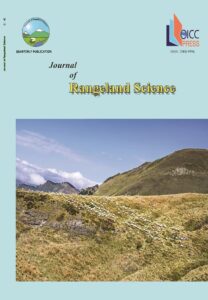Effect of Plant Density on Aerial Dry Matter and Essential Oil Yield of Two Native Thyme Species (Thymus kotschyanus and T. daenensis) under Dryland Farming in Lorestan Province, Iran
Authors
Abstract
The thymus is one of the most important medicinal plants in Lorestan province, Iran. In order to study the effect of plant density on the aerial dry matter (DM) yield and oil production, an experiment was conducted using two native Thyme species (Thymus kotschyanus and T. daenensis) in a split plot design based on a completely randomized block with three replications over four years (from 2016 to 2019) in Zagheh, Lorestan province, Iran. Seeds were sown in pots in the greenhouse, then seedling transferred to the field in seven-leaf stage in April 2016. The distance between the rows were 5 cm and between plants within the row were 25, 35, and 50 cm. This distance was corresponded to the density of 4, 6 and 8 plants/m2. Plant essential oils were extracted using Clevenger apparatus and their compounds were identified in GC-MS analysis. Data were analyzed using split plot in time and years were considered as subplots. Results of ANOVA showed significant differences between years, species and species by year interaction for many traits (p<0.05). The effect of density was significant for canopy diameter and stem number (p<0.05). Higher DM yield (2761.7 and 3332.5 Kg.h-1) and essential oil yield (44.83 and 75.28 Kg.h-1) were obtained in T. kotschyanus and T. daenensis, respectively, in the third year of study. So, essential oil production increased in T. kotschyanus over years, but in T. daenensis, it was increased up to third year, then decreased in the fourth year. In both Thyme species, the higher DM and essential oil yield were obtained in 6 and 8 plants/m² density without significant difference between these two densities. For the main compounds of essential oil, a moderate value of carvacrol (18%) and Thymol (51%) were obtained in T. kotschyanus and a lower value of carvacrol (5%) and higher value of Thymol (78%) were obtained in T. daenensis in the third year of study. Based on the obtained results, the cultivation of both species in density of 6 and 8 plants/m2 was recommended in the rain fed area and rangeland of Lorestan province, Iran.




